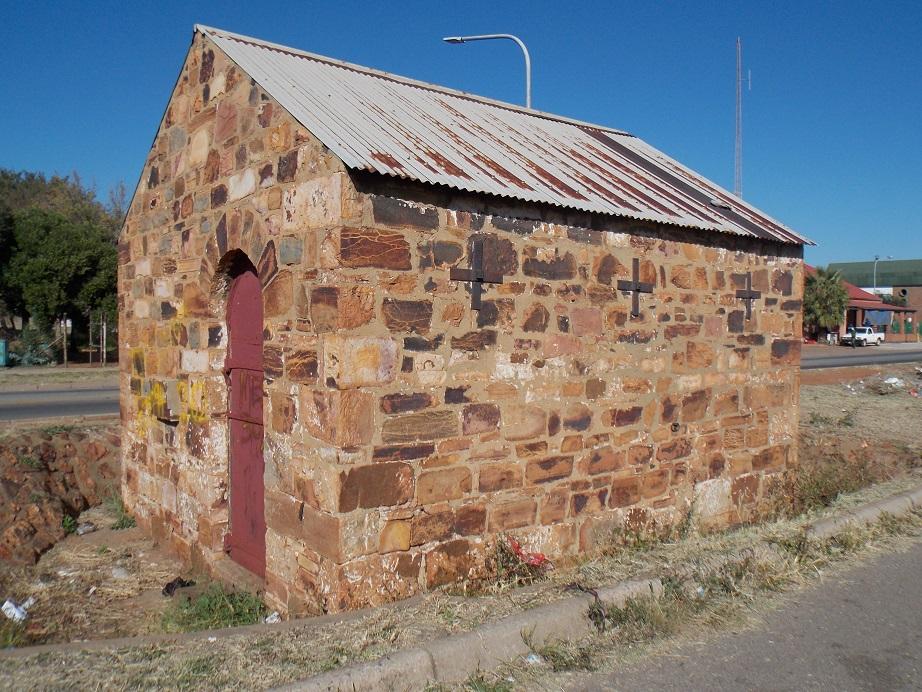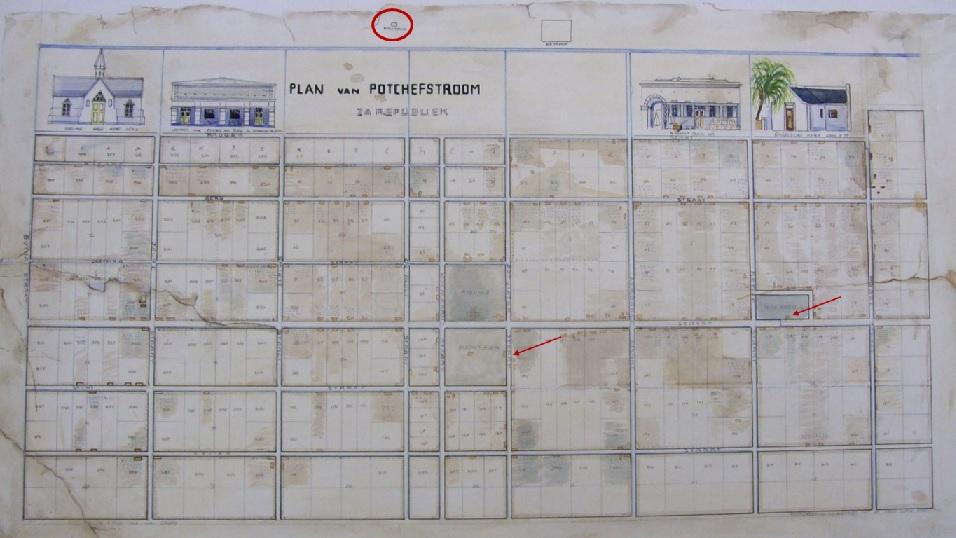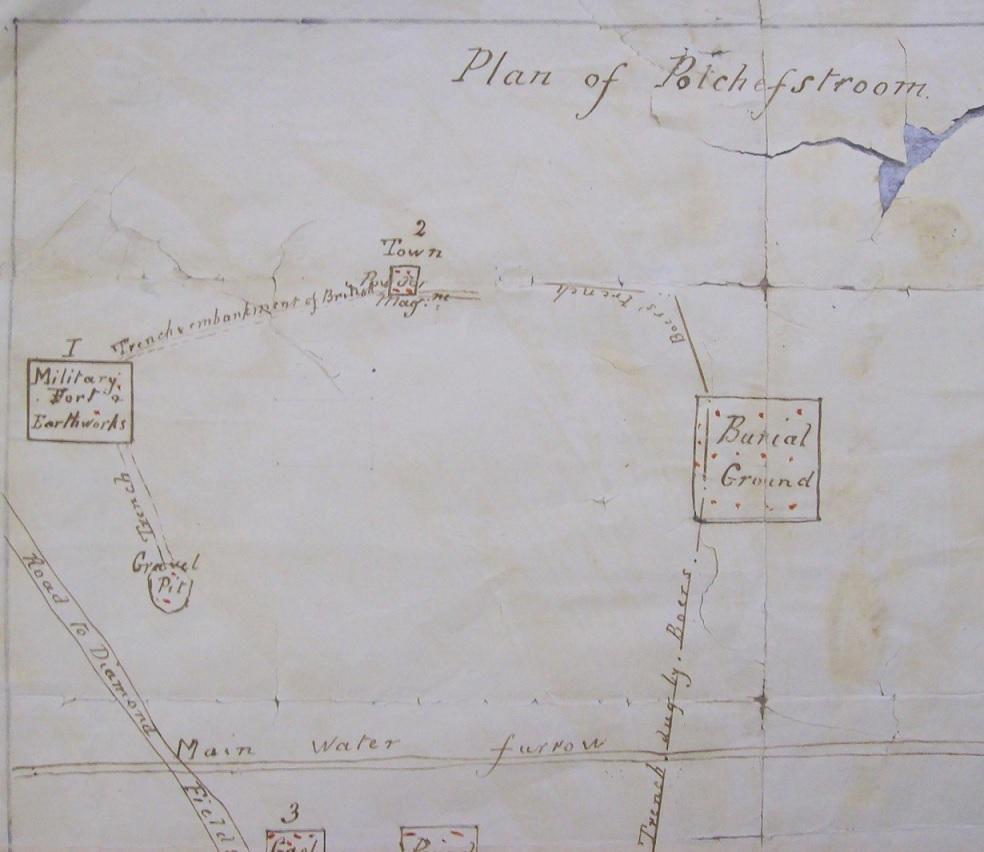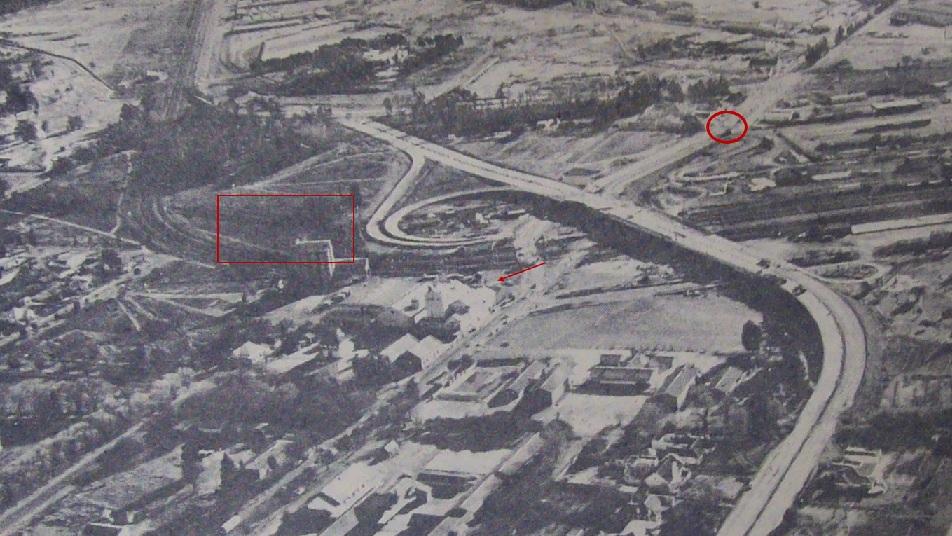
Disclaimer: Any views expressed by individuals and organisations are their own and do not in any way represent the views of The Heritage Portal. If you find any mistakes or historical inaccuracies, please contact the editor.
Nowadays it is a very humble building, standing in a place where it does not make any sense. Hundreds of travellers pass it every day where it stands next to the on-ramp to the N12 from Potchindustria, presumably not knowing what it is. This is the gunpowder magazine or store of Potchefstroom, one of the oldest buildings in town (see main image). It was declared a National Monument on 31 August 1973, the third site in Potchefstroom to receive that status. Currently it is a Grade 2 listed Provincial Heritage Site.
The huge demand for gunpowder for hunting and war was a characteristic of the South African pioneer community since the arrival of Europeans in South Africa. Before the use of more modern guns firing a single bullet that became available in the 1870s, guns were loaded with loose powder and round bullets or buckshot.
Gunpowder, or black powder, was used as a propellant in guns and cannons during the 1800s. Gunpowder consists of sulphur and charcoal (fuels), mixed with potassium nitrate (an oxidiser – a type of chemical which a fuel requires in order to burn). It was introduced to Europe in the 13th century by a Franciscan monk, Roger Bacon. One kilogram of gunpowder has the explosive force of about 5 000 horsepower, hence the necessity to store it far away from built-up areas where an accidental explosion can cause harm to people and structures.
This serious danger of explosions and fire caused by gunpowder led to the building of gunpowder magazines in all Voortrekker towns.
Magazine could only be built after town moved
It is uncertain exactly when the first gunpowder magazine of Potchefstroom was built. In 1841 JJ Hudson appealed to the Volksraad in Pietermaritzburg that a gunpowder magazine be built locally. This request was referred to the deputy council (Adjunkraad) in Potchefstroom. This council decided that the magazine could only be built after the town had moved from its first locality at Oudedorp, south of the Boskop Dam, to the current site.
Initially the new town was sparsely populated and according to Prof Gert van den Bergh in his unpublished history of Potchefstroom, it can be assumed that a gunpowder magazine was erected near the first government building which stood on the first temporary market square (between Church (Walter Sisulu) and Retief Streets and Maury Lane). It seems to be more probable that the gunpowder of the government, of which there was always a sizeable quantity kept for commando purposes, was stored in the office of the magistrate himself.
In 1854 there was some gunpowder in storage, possibly gunpowder that was seized by Magistrate Botha from all over town. This was in preparation for an expected insurrection of local tribes which never happened.
In 1853, already, the War Council for these possible hostilities, decided to build a gunpowder magazine approximately 6 X 2,5 m.
The reason why a sturdy gunpowder magazine was not built, wrote Prof Van den Bergh, can be ascribed to the fact that the local leader of the Voortrekkers, Andries Potgieter, had the intention to vacate the town, due to the fact that Natal was annexed by British forces bringing the proximity of British forces too close for Potgieter’s liking. His aim was always to get as far away from British rule as he could .
At the time the market was relocated to the Market Square (surrounded by Potgieter (Nelson Mandela), Church (Walter Sisulu), Wolmarans and Gouws (Sol Plaatjie) Streets), it was decided to build a permanent gunpowder magazine outside the town. The reason probably being the rapid increase in market activities and the building of businesses around the market square. This heightened the dangers of building a gunpowder magazine near the market.
Far outside town
It appeared that the efforts of Andries Pretorius to revive Potchefstroom was the deciding factor to have the gunpowder magazine built. Under his chairmanship, the Council of War, which had the largest interest in the handling of ammunition, decided to have the gunpowder magazine built 500 yards from the water furrow in line with Potgieter Street at the western end of the town.
The building was to have been built of extra-baked bricks, the walls 75 cm thick. The exterior was to be plastered and lime-washed and it was to have one entrance with double doors, made from “boekenhout” (Cape beech). Good nails were to be used. Above the long walls, a stone vaulted roof was to be installed. Over this the pitched roof was to rest on four well-anchored trusses.
The site and specifications of the gunpowder magazine is indicative of the awareness of the Council of War about the fire hazard this could present.
Available sources do not have information about the execution of these specifications. The fact that gunpowder was still stored in the office of the magistrate on the old market square, a year later, indicates that this did not happen quickly.
When the magistrate’s office moved to the new market square in 1854, the building of a gunpowder magazine became a matter of urgency.
By the middle of 1858 the magazine was still not built. State Secretary Moll, at the time, placed an urgent order for 1000 lb (450 kg) gunpowder and 1 125 kg lead at Winburg in the Free State. The shortage of money in the country compelled the government to collect money from the public for which, in turn, they would have received tax concessions. In the mean-time the ammunition commandant and the magistrate was advised to find proper storage for the ammunition.
Only built by April 1860
A government clerk was temporarily appointed as keeper of the gunpowder magazine. By September 1859 the floor of the magazine was laid and by April 1860 the building had certainly been completed.
Building work was apparently completed in haste, probably under pressure of the Council of War. This hasty completion was probably the reason why, in 1860, already repairs had to be made.
A map drawn by Fred Jeppe in 1863 depicts the magazine. It is shown on the map to be not in line with Potgieter Street, as initially ordered, but more in line with Du Plooy Street. It seems that Jeppe’s placement of the magazine on his map was not quite accurate if the 1860 magazine and the later ones stood more or less in the same area as indicated below. The current magazine is in line with Wolmarans Street and would have been at the time it was built, about 700 m from the nearest buildings.
The 1863 map, drawn by Fred Jeppe, showed the gunpowder magazine outside the town (circle top centre). Other places of interest are the first magistrate’s office on the old market square (arrow right) and the second magistrate’s office on the market square bordering on Potgieter Street (arrow left). The map is in the collection of the Potchefstroom Museum.
It appears that this second magazine also did not meet expectations and the building of a third one was considered. This is because Glen Scorgie, in 1868, offered to the government to build a new gunpowder magazine. In 1872 he wrote to the government to propose that the old magistrate’s office on the new market square, as well as the church on the church square be demolished and that the building material from these be used to build a new gunpowder magazine.
In July the next year, 1873, a plan of the proposed new magazine was presented to the government and tenders for the building thereof were requested. This time building work progressed faster. Before the end of the year the first payment was made and by March 1874 the magazine was completed. The magazine keeper requested that a lightning-conductor be installed.
The only indication of how the new magazine looked, appeared from the Scorgie plan. The building was twice the width of the former one, but of the same length. This one was also to be stone-vaulted, but stones above the single door had rested on a stone lintel. This third magazine was built from stone, but the second one was built with bricks. This one stood near the previous one.
Magazine wanted by both parties in War
During the First Anglo-Boer War (1880-1881) the gunpowder magazine played an enormous role in the skirmishes between the British soldiers and Boer warriors during the Siege of the Fort (click here to read more). Nowadays the large bridge on the N12 is a barrier between the Fort and the gunpowder magazine, but at the time there was an unobstructed distance of about 320 metres between them.
Arriving in Potchefstroom between 14 and 20 November 1880, the 233 British soldiers who came from Rustenburg and Pretoria, decided to set up camp near the gunpowder magazine. These British forces also confiscated all weapons and ammunition in possession of the merchants in town and stored it in the gunpowder magazine.
After the British forces were forced to retreat to the relative safety of the Fort and besieged there, one of their objectives was to occupy the magazine. Trenches were dug from the Fort to the magazine and they partially demolished the magazine for the stones to be used to build their defences.
The gunpowder magazine, seen here top centre and marked “2”, on the map drawn by Mrs Anna Palk. The positions of the trenches dug by both parties are also depicted. This is only the top left-hand side of the map. The article referred to above about the Siege of the Fort, gives more information on this map.
After the beginning of the Siege, both parties endeavoured to take the gunpowder magazine in possession and dug trenches in its direction. This is clear from the map of Mrs Anna Palk.
According to WJ Badenhorst in Potchefstroom 1838-1938, the trenches of the Boers were made with short turns (not depicted on the map). These twisting trenches were safer since the enemy could not fire down the trench and cause much damage. Badenhorst remarked that D van Graan and F Muller dug the Boer trenches.
The partially-demolished gunpowder magazine looked like this after the Siege of the Fort in 1881 (Potchefstroom Museum)
During the Siege, Lieutenant Rundle broke into the magazine on the night of 2 January 1881. A ton of gunpowder and more than 30 000 rounds of ammunition were plundered. On 3 January 1881 the Boers bombarded the magazine.
After the War, a fourth gunpowder magazine had to be built and it was done in 1882. This is the one still standing today.
Initially shopkeepers were forced to keep their main supply of gunpowder in the magazine and were only allowed to keep a small amount in their shops. When a client wanted to buy a larger amount than was available in the shop, he was supplied with a purchase letter, which was to be presented to the keeper of the magazine. The keeper would then hand over the amount of gunpowder from the shop’s supply. The main purpose of the magazine was, however, to store the gunpowder of the government for use by the military and police forces. In cases of extreme emergency the stock of the shopkeepers could be confiscated.
Types of ammunition changed size of magazine
It is noticeable that the gunpowder magazine built after the 1880/81 War was half the size of the previous one. The reason probably being that loose gunpowder was then replaced by sharp-pointed one-piece ammunition, which diminished fire hazard of storing gunpowder in bulk to the minimum. This allowed shopkeepers to store their complete stock of ammunition in their shops. The magazine was afterwards only used to store ammunition for the government.
During the early 1970s a large scale archaeological excavation took place at the Fort. It is in this time that the gunpowder magazine was declared a National Monument.
When the large bridge over the railway line was built, also in the 1970s, great care was taken to take the gunpowder magazine into consideration in the planning. The magazine stood where the on-ramp to the N12 began, making its foundations lower than ground level. Hence an embankment was built around it with steps leading down to the door.
This photo shows the bridge on the N12 over the railway line when building was in progress. It was taken by the well-known photographer, Piet van Maarleveld and appeared in the Potchefstroom Herald of 4 September 1970. The gunpowder magazine is top right in the red oval. The Fort is centre left in the square and the arrow points to the Snowflake Building.
In spite being disfigured by graffiti, the gunpowder magazine still stands strong, initially built to withstand an explosion exceeding 5 000 horsepower and now only being a symbol of a bygone era.
Main image: The Potchefstroom gunpowder magazine, standing next to the on-ramp from Potchindustria to the N12, is almost a century and a half old. It stands across the road from the old prison, which itself dates from the 1890s.
This article first appeared on Lennie's blog. Click here to view more of her writing.
About the author: Somewhere in her late teens Lennie realised that writing came easy to her and now, many decades later, she has written and co-written nine books on various aspects of the history of Potchefstroom. This is apart from various supplements and numerous articles, mostly published in the Potchefstroom Herald. Three of her books are available on amazon.com. One is a biography on Kenneth McArthur, Olympic gold medallist in the marathon of 1912. The other two are Afrikaans Christian novels. The supplement on the history of the Herald, at the time of its centenary in 2008, led to a Master’s degree in Communication Studies and one of the books, on NWU PUK Arts, led to a PhD in history. In the process of all this writing she has accumulated a large stash of information and photos on the history of Potchefstroom.
Comments will load below. If for any reason none appear click here for some troubleshooting tips. If you would like to post a comment and need instructions click here.




